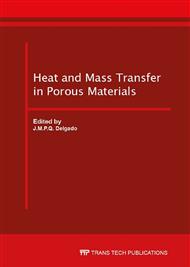[1]
A. J. Lotka, Contribution to the energetics of evolution, Proc. Natl. Acad. Sci. USA 8 (1922) 147–151.
Google Scholar
[2]
A. J. Lotka, Natural selection as a physical principle, Proc. Natl. Acad. Sci. USA 8 (1922) 151–154.
Google Scholar
[3]
I. Prigogine, Structure, dissipation and life, in: M. Marois (Ed. ), Theoretical Physics and Biology, North-Holland, Amsterdam, 1969, p.23–52.
Google Scholar
[4]
P. Glansdorff, I. Prigogine, Thermodynamic Theory of Structure, Stability, and Fluctuations, Wiley-Interscience, New York, (1971).
DOI: 10.1126/science.176.4042.1410
Google Scholar
[5]
D. Kondepudi, I. Prigogine, Modern Thermodynamics, From Heat Engine to Dissipative Structures, Wiley, New York, (1999).
Google Scholar
[6]
A. F. Miguel, Quantitative unifying theory of natural design of flow systems: emergence and evolution, in: L. Rocha, S. Lorente, A. Bejan (Eds. ), Constructal Law and the Unifying Principle of Design, Springer, New York, 2013, chapter 2, p.21–38.
DOI: 10.1007/978-1-4614-5049-8_2
Google Scholar
[7]
I. Prigogine, Time, structure, and fluctuations, Science 201 (2001) 777–785.
Google Scholar
[8]
A. F. Miguel, The emergence of design in pedestrian dynamics: locomotion, self-organization, walking paths and constructal law, Physics of Life Reviews 10 (2013) 168–190.
DOI: 10.1016/j.plrev.2013.03.007
Google Scholar
[9]
A. F. Miguel, Toward an optimal design principle in symmetric and asymmetric tree flow networks, Journal of Theoretical Biology 389 (2016) 101-109.
DOI: 10.1016/j.jtbi.2015.10.027
Google Scholar
[10]
I. Dincer, Y. A. Cengel, Energy, entropy and exergy concepts and their roles in thermal engineering, Entropy 3 (2001) 116–149.
DOI: 10.3390/e3030116
Google Scholar
[11]
A. F. Miguel, M. Aydin, Ocean exergy and energy conversion systems, Int. J. of Exergy 10 (2013) 454–470.
DOI: 10.1504/ijex.2012.047507
Google Scholar
[12]
A. F. Miguel, A study of entropy generation in tree-shaped flow structures, International Journal of Heat and Mass Transfer 92 (2016) 349–359.
DOI: 10.1016/j.ijheatmasstransfer.2015.08.067
Google Scholar
[13]
H. Ziegler, Introduction to Thermomechanics, North-Holland, Amsterdam, (1983).
Google Scholar
[14]
H. Ziegler, C. Wehrli, On a principle of maximal rate of entropy production, J. Non-Equilib. Thermodyn. 12 (1987) 229–243.
Google Scholar
[15]
L. M. Martyusheva, V. D. Seleznev, Maximum entropy production principle in physics, chemistry and biology, Physics Reports 426 (2006) 1– 45.
DOI: 10.1016/j.physrep.2005.12.001
Google Scholar
[16]
M. Batato, L. Borel, O. Deriaz, E. Jequier, Analyse exergétique théorique et expérimentale du corps humain, Entropie: Énergétique et Dynamique des Systèmes Complexes: la revue internationale des sciences et techniques en énergétique, génie chimique, génie biologique 153/154 (1990).
DOI: 10.3917/dunod.feidt.2014.01.0861
Google Scholar
[17]
M. Prek, Thermodynamical analysis of human thermal comfort, Energy 31 (2006) 732–743.
DOI: 10.1016/j.energy.2005.05.001
Google Scholar
[18]
M. Saito, M. Shukuya, The human body consumes exergy for thermal comfort, Low-Ex News 37(2): 5e6. IEA/ECBCS-Annex, (2001).
Google Scholar
[19]
M. Shukuya, M. Saito, K. Isawa, T. Iwamatsu, H. Asada, Human-body exergy balance and thermal comfort, IEA/ECBCS-Annex49 Report, (2010).
Google Scholar
[20]
A. Simone, J. Kolarik, T. Iwamatsu, H. Asada, M. Dovjak, L. Schellen L, M. Shukuya, B.W. Olesen, A relation between calculated human body exergy consumption rate and subjectively assessed thermal sensation, Energy and Buildings 43 (2011) 1–9.
DOI: 10.1016/j.enbuild.2010.08.007
Google Scholar
[21]
C. E. K. Mady, M. S. Ferreira, J. I. Yanagihara, P. H. N. Saldiva, S. Oliveira Jr., Modeling the exergy behavior of human body, Energy 4 (2012) 546–553.
DOI: 10.1016/j.energy.2012.02.064
Google Scholar
[22]
C. E. K. Mady, M. S. Ferreira, J. I. Yanagihara, S. Oliveira Jr., Human body exergy analysis and the assessment of thermal comfort conditions, International Journal of Heat and Mass Transfer 77 (2014) 577–584.
DOI: 10.1016/j.ijheatmasstransfer.2014.05.039
Google Scholar
[23]
A. Simone, J. Kolarik, T. Iwamatsu, H. Asada, M. Dovjak, L. Schellen, M. Shukuya, B. W. Olesen, A relation between calculated human body exergy consumption rate and subjectively assessed thermal sensation, Energy and Buildings 43 (2011) 1–9.
DOI: 10.1016/j.enbuild.2010.08.007
Google Scholar
[24]
G. Bisio, A. Bisio, Some thermodynamic remarks on photosynthetic energy conversion, Energy Conversion and Management, 39(1998) 741–748.
DOI: 10.1016/s0196-8904(97)10042-5
Google Scholar
[25]
A. H. Reis, A. F. Miguel, Analysis of the exergy balance of green leaves. International Journal of Exergy, 3 (2006) 231–238.
DOI: 10.1504/ijex.2006.009779
Google Scholar
[26]
S.E. Jørgensen, Y. M. Svirezhev, Towards a Thermodynamic Theory for Ecological Systems, Elsevier, Amsterdam, (2004).
Google Scholar
[27]
R. Petela, An approach to the exergy analysis of photosynthesis, Solar Energy 82 (2008) 311–328.
DOI: 10.1016/j.solener.2007.09.002
Google Scholar
[28]
S. Lems, H. J. van der Kooi, J. de Swaan Arons, Exergy analyses of the biochemical processes of photosynthesis, Int. J. Exergy 7 (2010) 333–351.
DOI: 10.1504/ijex.2010.031988
Google Scholar
[29]
C. S. Silva, W. D. Seider, N. Lior, Exergy efficiency of plant photosynthesis, Chemical Engineering Science 130 (2015) 151–171.
DOI: 10.1016/j.ces.2015.02.011
Google Scholar
[30]
A. Bejan, I. Dincer, S. Lorente, A. F. Miguel, A. H. Reis, Porous and Complex Flow Structures in Modern Technologies, Springer, New York, (2004).
DOI: 10.1007/978-1-4757-4221-3
Google Scholar
[31]
M. Pessarakli, Handbook of photosynthesis, 2nd ed., CRC Press, Boca Raton, (2005).
Google Scholar
[32]
A. F. Miguel, A. Silva, Solar irradiation in diffusely enclosures with partitions, Applied Energy 87 (2010) 836–842.
DOI: 10.1016/j.apenergy.2009.10.003
Google Scholar
[33]
I. Muñoz, L. M. Canals, R. Clift, G. Doka, A simple model to include human excretion and wastewater treatment in Life Cycle Assessment of food products, Centre for Environmental Strategy, University of Surrey, Guildford (Surrey), (2007).
Google Scholar
[34]
J. M. Berg, J. L. Tymoczko, L. Stryer, Biochemistry, W. H. Freeman, New York, (2002).
Google Scholar
[35]
A. F. Miguel, Lungs as a natural porous media: architecture, airflow characteristics and transport of suspended particles, in: J.M.P.Q. Delgado (Ed. ), Heat and Mass Transfer in Porous Media, Advanced Structured Materials Series (volume 13), Springer, Berlin, 2012, chapter 5, p.115.
DOI: 10.1007/978-3-642-21966-5_5
Google Scholar
[36]
J. R. B. Lighton, Measuring Metabolic Rates: A Manual for Scientists, Oxford University Press, Oxford, (2008).
Google Scholar
[37]
A. C. Burton, O. G. Edholm, Man in a Cold Environment, Edward Arnold, London, (1955).
Google Scholar


